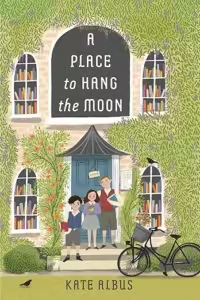A Place to Hang the Moon
Kate Albus
Margaret Ferguson Books
Published February 2, 2021
Amazon | Bookshop | Goodreads
About A Place to Hang the Moon
Set against the backdrop of World War II, Anna, Edmund, and William are evacuated from London to live in the countryside, bouncing from home to home in search of a permanent family.
It is 1940 and Anna, 9, Edmund, 11, and William, 12, have just lost their grandmother. Unfortunately, she left no provision for their guardianship in her will. Her solicitor comes up with a preposterous plan: he will arrange for the children to join a group of schoolchildren who are being evacuated to a village in the country, where they will live with families for the duration of the war. He also hopes that whoever takes the children on might end up willing to adopt them and become their new family–providing, of course, that the children can agree on the choice.
Moving from one family to another, the children suffer the cruel trickery of foster brothers, the cold realities of outdoor toilets, and the hollowness of empty tummies. They seek comfort in the village lending library, whose kind librarian, Nora Muller, seems an excellent candidate–except that she has a German husband whose whereabouts are currently unknown. Nevertheless, Nora’s cottage is a place of bedtime stories and fireplaces, of vegetable gardens and hot, milky tea. Most important, it’s a place where someone thinks they all three hung the moon. Which is really all you need in a mom, if you think about it.
Fans of The War That Saved My Life and other World War II fiction will find an instant classic in A Place to Hang the Moon.
My Review
I have so many things to say about this book I’m having a hard time figuring out where to start. I love the way it’s written from the perspective of all three children. In the beginning, I wasn’t sure that would work, but it actually truly does. It makes them feel like a unit and yet the narrative zooms in on one child’s thoughts or feelings at critical moments in the story.
The book feels firmly anchored in WWII England, and not in a romanticized way. William, Edmund, and Anna face hunger, see families affected by missing family members serving in the military, worry about German invasion and air strikes.
Yet the story also celebrates a love of literature and mentions several beloved children’s stories. In particular, Anna finds comfort in The Little Princess, which holds some parallels to the children’s lives and experience. It also celebrates found family and the power of sibling bonds in a beautiful way.
A Place to Hang the Moon is the first book by Kate Albus that I’ve read, but it absolutely won’t be the last. Fans of historical fiction or sibling stories will not want to miss this one.
Content Notes
Recommended for Ages 8 to 12.
Representation
Main characters are white.
Profanity/Crude Language Content
Two boys bully the main characters, using a slur to describe them. Some characters use a slur meaning German people.
Romance/Sexual Content
A girl has an obvious crush on William. Her attention makes him uncomfortable.
Spiritual Content
The children participate in a Nativity play at Christmas at the local church. They celebrate Christmas together.
Violent Content
The opening scene is a funeral wake for the children’s grandmother and former guardian. References to war. The children are aware of other places being bombed and invaded by the German army. In some scenes, children worry that bombs will fall on the place they’ve been evacuated to. Brief reference to an internment camp in which Germans living in England have been imprisoned. Another character dies (offscene).
At one point, the boys go to a farm to participate in a rat extermination event in which a group of boys use sticks, clubs, and other weapons to strike and kill rats. They earn money for each kill. William and Edmund feel pretty disturbed about the whole thing.
Drug Content
None.
Note: This post contains affiliate links, which do not cost you anything to use but help support this blog. All opinions are my own.
